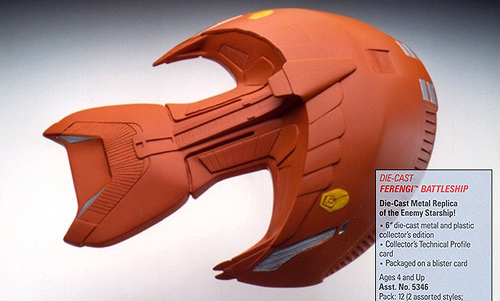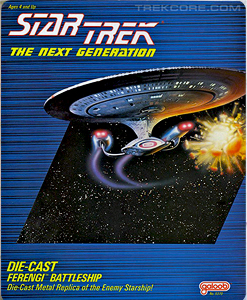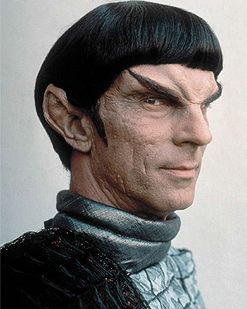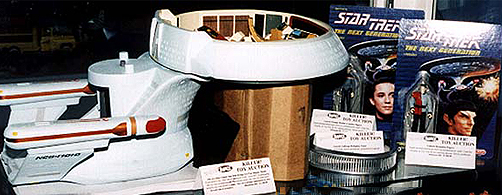TrekCore: Moving on to the second year of production — one new addition in the 1989 catalog was a die-cast Ferengi Battleship to go along with the first year’s die-cast Enterprise.
Jim Fong: The Ferengi die-cast ship was first made from plastic so we could see the size and scale of the toy, and it was mounted on the Enterprise backing card so we could get a sense of how it would look in the retail packaging.
 |
|
 |
 |
| Top: The catalog image of the proposed die-cast Ferengi Battleship. Bottom: A prototype on an Enterprise backing card; the final card artwork. (Photos: Bob DiGiacomo; RebelScum forums user “phreaky_d“) | |
Once that was approved, the ship was prototyped as a raw, unpainted casting, and the final model was painted the same burnt orange coloring as the Ferengi ship seen on the show. There were maybe around five of these made, all of which are probably in collectors’ hands today.
TrekCore: We know those Wesley and Romulan prototype figures were sent from the Hong Kong manufacturer on were sent from China on substitute Riker and Picard, but at least a few were eventually mounted on ‘real’ card backs for the Toy Fair expos. How many of these were produced?
Jim Fong: Our Hong Kong office mounted the first prototypes on whatever cards they had available – in this case, the older Riker and Picard production cards. Once they had character-specific cards completed, they packaged additional prototypes on them and send samples to us for approval.
 |
|
 |
 |
 |
|
| Top: The initial figures, shipped to the US on existing backing cards. Bottom left: The final packaging designs, with proper text and photography. Bottom right: The original design sketch for the Wesley Crusher figure. (Photos: Bob DiGiacomo, “phreaky_d”, Enrico from StarTrek-Collection.nl) | |
As far as production numbers go, I can’t remember – I doubt if there were more than a dozen of each made, but whatever samples survived are now in the hands of collectors.
TrekCore: Speaking of Romulans, can you tell us anything about the additional Romulan products listed on the R&D budget paperwork?
Bob DiGiacomo: Well, you can see that several of the things listed on that budget chart don’t even have costs listed – basically, it was a wish list of products, most of which would eventually be dropped. Sometimes there may have been sketches for the different ideas or – like the radio and walkie-talkies – they may have taken off-the-shelf products and just slapped the appropriate labels onto them. They would come up with all these different ideas for things and then decide they weren’t going to happen.
The whole scenario can become very complicated. The old-fashioned sales reps were very involved with the buyers – a lot of wining and dining, stuff like that – because in the early days, all of our reps worked on commission. One guy would have Toys ‘R Us, another would have Wal-Mart; somebody else would have a chain of regional stores you might have never heard of. The sales reps were very important, because not only would they keep the buyers happy, but they’d often basically come out and tell them what products to buy! They’d tell the buyers which lines would be the “good” buys, and so forth.
 |
 |
| Left: Budget proposals for a third wave of Romulan-based accessory toys. Right: Marc Alaimo poses for a reference photo to be used by Galoob sculptors. (Budged scan: Bob DiGiacomo; Alaimo photo via Star Trek: TNG 365) | |
The other important thing is that they would work to make sure the buyers knew which lines would have TV advertisements, and when the commercials would air. That was very, very important – if buyers saw that the line wouldn’t be on television, they would assume that it wasn’t prominent enough and they wouldn’t be interested in spending money on it – unless the line really took off.
At Toy Fair, we’d have all of our commercial reels playing, and we’d make sure to take copies to show directly to the buyers, and make sure they knew when the ads would be playing.
TrekCore: What can you tell us about your Toy Fair experiences?
Bob DiGiacomo: Toy Fair is run out of New York City – there are two toy buildings in Manhattan; Galoob started out in a very small showroom in the building on Broadway, and later we moved over to the main Toy Fair building.
The early show was in October – we called it pre-Toy Fair, because the main show was in February – and it took place in part of the showroom with the revolving cylindrical displays shown in some of the photos. There were twenty-four of those, stacked two high, with a large stationary display area in the middle.
 |
|
 |
|
| A scene from the 1989 ToyFair show, featuring nearly every prototype and product. (Photos: Bob DiGiacomo) |
I would usually set up the smaller regional shows on my own, although sometimes I would hire another modelmaker to help. We usually didn’t go to the expense of sending many people to the smaller shows due to the cost of the flights and hotels.
Toy Fair, though, was something different; it was a really big extravaganza. We’d have the product managers for each toy line with us at the show to train the demonstrators on all the different toys that were on display, and we would hire local modelmakers out of New York City to help out during the show as well.
In the early days, we would have an outside designer come up with the look of the showroom, which would then be approved by our marketing team – later on, our in-house packaging and design group would create the showroom concepts – but after they finished the major displays, I would come in and set up all the prototypes for the show, along whoever may have been needed from San Francisco.
Once the show started and groups would start coming through, we had these demonstrators who would learn every piece in the toy line for the buyers’ benefit. A buyer would come in, and the demonstrator would show off the line and go through the whole sales pitch.
 A ToyFair endcap setup, showcasing a proposed in-store display for Galoob’s Trek line.
A ToyFair endcap setup, showcasing a proposed in-store display for Galoob’s Trek line.
This photo contains the only known images of the inflatable and electronic Enterprise,
Enterprise bridge playset, and radio walkie-talkie packaging designs.
(Photo: Bob DiGiacomo)
Toy Fair would run from the crack of dawn to late into the night – and then once the day was over, we’d have to deal with repairing things that either broke down or were broken by the show attendees.
It used to be this big thing, having all these international buyers come into New York for the show, but in the later years, the show started to become a bit redundant because most of our sales were done before Toy Fair, so it was more of a party. They’d come into New York, go to restaurants, take in a play; it was more like an excuse to come into the city.
TrekCore: There was one other piece of long-rumored merchandise we wanted to ask about — a wearable VISOR accessory, like the one worn by LeVar Burton on the show. The only evidence that we’ve ever been able to find that it even existed is a photo taken at a toy auction in the late 1990s a toy auction, posted online about 15 years ago… was this a Galoob product?
Jim Fong: Yes, that one was ours. It wasn’t as exciting to me as the playset – I think that it was just another one of those ‘filler’ products to fill out the line. When I saw the actual VISOR prop at Paramount, it was very cool, but there wasn’t really much that I could do with it to turn it into a toy with any real play value.
 |
 |
| Left: The screen-used VISOR prop, as seen at Paramount Studios. Right: Galoob’s rather realistic prototype VISOR accessory toy. (Photos: Bob DiGiacomo, Jim Fong) | |
Yes, it was something to wear – so it added to the level of make-believe that would be fun – but from a design point of view, there wasn’t much for us to do. We weren’t going to add additional features that would contradict the authenticity off the product; should it have gone into production, I’m sure kids would have loved it.
I wasn’t aware that ended up at auction, but whoever has it now is lucky – they’ve got a very, very rare piece in their collection.
Bob DiGiacomo: Actually, the Trek toys at that auction all came from me! I gave Mike Herz – who ran the Whiz Bang! toy shop down in Florida – a bunch of my old stuff for that sale.
TrekCore: Compared to the Playmates Toys license – a juggernaut which dominated the Trek landscape for most of the 1990s – the Galoob line of Next Generation toys barely lasted two years. Why do you think Galoob’s production ended so quickly?
Jim Fong: That’s a really tough question to answer. We were all obviously disappointed when everything stopped, but I can give you my ideas about why the line was dropped.
When we first landed the Trek license, the show was brand new and hadn’t even aired – which means that we had to guess which characters would be the most popular, and which would generate the most interest from consumers.
In other words, we had to figure out how many of each figure (Data, Geordi, Worf, etc.) to include in each shipment, using only our instincts and Paramount-provided show information. This is risky, because if we decide that Riker, for example, will be more popular than Geordi – and we’re wrong – that will impact sales. If we guess incorrectly, and it turns out that we made too many Riker figures and not enough Geordi toys – causing sales to slow down – then buyers begin to hesitate when it comes to carrying the line for a second year, causing the whole line to be in danger of cancellation.
When Galoob was producing Next Generation toys, the show was brand new, so there was a lot of guesswork that went into deciding what products we should do. We tried a little bit of this, a little bit of that, never really committing to any of the offerings; in the end, we may have been a bit too timid.
 |
 |
| A 1989 Intergalactic Trading Company ad offering a “free Bearded Riker” with purchase. These figures were hand-customized by the ITC staff with a black marker as a way to unload a supply of extra Riker figure inventory due to lack of sales. |
We were such a small company, and it would have been a massive risk to bet everything on the Trek line – if we lost the bet, we would have suffered greatly. That’s why the line wasn’t so extensive at launch, and why we didn’t have a real show of force that would have told the world we were confident and committed to the Star Trek brand.
Bob DiGiacomo: The other issue may have been the royalty costs. For licensed items, royalties can be very high; I think that the Star Trek license was somewhere around 10% – and they’d write the licenses so many different ways, and after a set period of time things would have to be renegotiated. I know that the Star Wars license was brutal – Galoob used to pay like a 17% royalty on that!
Sometimes we would end up losing money when it came to dealing with Toys ‘R Us or Wal-Mart – Toys ‘R Us was big, but Wal-Mart really became the proverbial eight-hundred-pound gorilla in the marketplace. They first beat up Toys ‘R Us in sales, then they went after everybody else. Wal-Mart would tell us to do something and everybody would jump through hoops to get it done.
Because Wal-Mart and Toys ‘R Us were the big national players, they could sell the toys at a loss to get people to come into the store for the deal – these “loss leaders” would then hopefully get those customers to buy other products while they were at the store to make up the cost difference. The smaller competitors couldn’t match those discounts, so they often wouldn’t renew their orders for the second run of the toy line.
Marketing would have to figure out the costs, and they could easily end up deciding that the numbers just wouldn’t work.
Jim Fong: I suppose that it’s possible that what we designed just wasn’t good, but I hate to think that; we did the best we could with the limited resources we had. We gave it our all, but it didn’t pan out the way we hoped – but I’m hoping that the people who actually bought the toys enjoyed them and had fun playing with them.
Personally, I think that Playmates did a terrific job with the Trek toys. By the time they took over the Next Generation line, the show had matured and had become a much more established series, which is a huge benefit for any toy company. It allowed their designers to have a better understanding of which characters the audiences like, Nielson ratings, fan-favorite episodes, the most-feared enemies… there’s just a much larger canvas to work with.
 Just a sampling of the massive Trek catalog of figures released by Playmates Toys.
Just a sampling of the massive Trek catalog of figures released by Playmates Toys.
TrekCore: We really can’t thank the two of you enough for all the information you provided while we worked to put this series together – there’s been so much speculation and conflicting information out there about the Galoob toys, and we’re glad to have had the chance to set the record straight on how things really went down back in 1988.
Jim Fong: It’s shocking to think that twenty-five years have gone by already, but it’s nice to know that people are still interested in our Star Trek toys after all these years. Trek gave me a chance to visit Paramount and ILM, and meet behind-the-scenes people – some of which I’m still friends with today.
I know that there’s a lot of nebulous information floating about on the Internet; I think it’s important to get as many details as accurate as possible before everybody forgets everything. I’ve already forgotten so much, but we’re lucky to have so many images preserved for posterity.
This will likely be the definitive series on the Galoob’s Star Trek toys – all of us had a blast working on the Next Generation line, and I’m hoping that fans continue to enjoy the work we did long after we’re gone, as the toys continue to be sold and traded on the collector market.It’s much like Captain Kirk’s final monologue in The Undiscovered Country: “…this ship and her history will shortly become the care of another crew; to them and to their posterity will we commit our future.”
I hope that as time goes by, new generations of collectors will look at our old product line and find an appreciation for the work and care that we put into it. A little part of me will always be in those toys, and I’m honored, humbled, and privileged to have had a chance to work on the Trek line with some of the most talented designers, modelmakers, and marketers ever. The Galoobians may be split apart today, but we’ll always be a family.
< Part I: Launching the Next Generation of Trek Toys · Part II: Abandoned Artifacts






